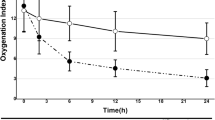Abstract
A retrospective study of all premature neonates who received artificial surfactant (Curosurf) at the Rotunda Hospital was performed. The period from October 1990 to June 1992 (n=48) was compared with the initial experience from June 1987 to January 1988 (n=15). In the initial period mortality rate was 67% in surfactant treated infants, and use of surfactant was not associated with an improvement in outcome compared with the previous six years. In the more recent period overall mortality was 21%. Overall survival in normally formed very low birthweight infants improved from 59% in 1986 to 86% in 1991–1992. Improvement in survival rates was most noticeable in infants with birthweight 750–999 grams, with survival increasing from 44% (before introduction of surfactant treatment) to 91% (in1991–1992).
It is probable that a certain level of experience with use of surfactant is required before optimal effects can be obtained.
Similar content being viewed by others
References
Donald, I., Lord, J. Augmented respiration. Studies in atelectasis neonatorum. Lancet 1952; i: 9–17.
Liggins, G. C., Howie, R. N. A controlled trial of antepartum glucocorticoid treatment for the prevention of the respiratory distress syndrome in premature infants. Pediatrics 1972; 50: 515–525.
Collaborative group on antenatal steroid therapy. Effect of antenatal dexamethasone administration on the prevention of respiratory distress syndrome. Am. J. Obstet. Gynecol. 1981; 141: 276–287.
Fujiwara, T., Maeta, H., Chida, S., et al. Artificial surfactant therapy in hyaline membrane disease. Lancet 1980; 1: 55–59.
Merritt, T. A., Hallman, M., Berry, C. et al. A randomised placebo controlled trial of human surfactant at birth versus rescue administration in very low birthweight infants with lung immaturity. J. Pediatr. 1991: 118, 581–594.
Kendig, J. W., Notter, R. H., Cox, C. et al. A comparison of surfactant as immediate prophylaxis and as rescue therapy in newborns of less than 30 weeks gestation. N. Engl. J. Med. 1991; 324: 865–871.
Hjalmarson, O. Epidemiology and clasification of acute neonatal respiratory disorders. A prospective study. Acta Paediatr. Scand. 1981; 70: 773–783.
Papile, L. A., Burstein, J., Burstein, R., Koffler, H. Incidence and evolution of subependymal and intraventricular hemorrhage: a study of infants with birthweight less than 1500 grams. J. Pediatr. 1978; 92: 529–534.
Collaborative European Multicentre Study Group. Surfactant replacement therapy for severe neonatal respiratory distress syndrome: an international randomised clinical trial. Pediatrics 1988; 82: 683–691.
Speer, C. P., Robertson, B., Curstedt, T. et al. Randomised European multicentre trial of surfactant replacement therapy for severe neonatal respiratory distress syndrome: single versus multiple doses of surfactant. Pediatrics 1992; 89: 13–20.
Fujiwara, T., Konishi, M., Chida, S., Maeta, H. Factors affecting the response to a postnatal single dose of a reconstituted bovine surfactant (Surfactant TA). In Lachmann, B., ed. Surfactant replacement therapy in neonatal and adult respiratory distress syndrome. Berlin: Springer Verlag, 1988, pp 9, 1–102.
Horbar, J. D., Soll, R. F., Schachinger, H. et al. European multicentre randomised controlled trial of single dose surfactant therapy for idiopathic respiratory distress syndrome. Eur. J. Pediatr. 1990; 149: 416–423.
McCord, F. B., Curstedt, T., Halliday, H. L. et al. Surfactant therapy and incidence of intraventricular haemorrhage in severe respiratory distress syndrome. Arch Dis. Child. 1988; 63: 10–16.
Leviton, A., van Marter, L., Kuban, K. C. K. Respiratory Distress Syndrome and intracranial haemorrhage: cause or association? Inferences from surfactant trials. Pediatrics 1989; 84: 915–920.
Cowan, F., Whitelaw, A., Wertheim, D. et al. Cerebral blood flow velocity changes after rapid administration of surfactant. Arch Dis. Child. 1991; 66: 1101–1109.
Wegman, M. E. Annual Summary of Vital Statistics -1990. Pediatrics 1991; 88: 1081–1092.
Author information
Authors and Affiliations
Rights and permissions
About this article
Cite this article
Gormally, S.M., Clarke, T.A., Krishnan, A. et al. Surfactant therapy in respiratory distress syndrome: The effect of a learning curve in improving outcome. I.J.M.S. 162, 458–461 (1993). https://doi.org/10.1007/BF02942189
Issue Date:
DOI: https://doi.org/10.1007/BF02942189




